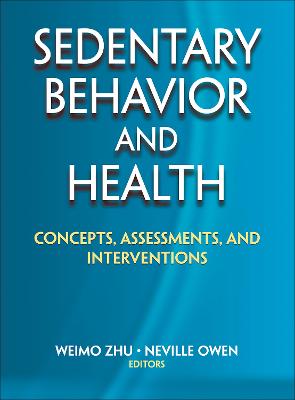Sedentary Behavior and Health
 -15%
portes grátis
-15%
portes grátis
Sedentary Behavior and Health
Concepts, Assessments, and Interventions
Owen, Neville; Zhu, Weimo
Human Kinetics Publishers
03/2017
456
Dura
Inglês
9781450471282
15 a 20 dias
1497
Chapter 1. Emergence of Research on Sedentary Behavior and Health
Neville Owen
Contemporary Sedentary Behavior Research and Concepts
Sedentary Behavior and Health
Sedentary Research Agenda
Sedentary Behavior Research Priorities
Summary
Chapter 2. Gravity, Sitting, and Health
Joan Vernikos
Gravity and Spaceflight
Head Down Bed Rest Studies
Gravity Deprivation Syndrome
Health Consequences of Prolonged Sitting and Gravity
Perceiving Gravity
Gravity Intervention Design and Implementation
Summary
Chapter 3. Physiological Effects of Reducing and Breaking Up Sitting Time
David W. Dunstan, Bethany J. Howard, Audrey Bergouignan, Bronwyn A. Kingwell, and Neville Owen
Methodological Considerations for Studies of Sedentary Behavior
Metabolic Effects of Reduced Sitting and the Postprandial State
Cardio Metabolic Effects Following Exposure to Reduced Sitting
Cardiometabolic Effects of Repeated-Day Exposure to Reduced Sitting
Public Health and Clinical Guidelines
Summary
Chapter 4. Rethinking the Chair and Sitting
Galen Cranz
Problems with Sitting in Chairs
Chair Designer Response
Postural Education
Summary
Chapter 5. Children and Screen Time
Jorge A. Banda and Thomas N. Robinson
Screen Time Exposure
Mobile Devices and Screen Time Changes
Influences on Media Use
Screen Time and Body Weight
Screen Time and Cardiometabolic Risk Factors
Screen Time, Physical Activity, and Cardiorespiratory Fitness
Screen Time and Dietary Habits
Experimental Studies of Reducing Screen Time
Summary
Part II. Sedentary Behavior and Health
Chapter 6. Economics of Sedentary Occupations
Kenneth A. Glover
Economic Sectors
Economics of Inactivity
Worksite Health Promotion
Regulation and Innovation
Choice Architecture
Summary
Chapter 7. Sedentary Behavior and Obesity
Michael L. Power
Role of Fat
Adipose Tissue and Endocrine Function
Mismatch Paradigm
Obesity and Inflammation
Central Versus Peripheral Obesity
Sex Differences in Fat Storage and Mobilization
Vitamin D, Adipose Tissue, and Sedentary Behavior
Obesity Prevalence
Summary
Chapter 8. Sedentary Behavior and Incident Diabetes
Carl J. Caspersen and G. Darlene Thomas
Diabetes Statistics
Key Risk Factors
Epidemiological Diabetes Research
Research Limitations
Six Criteria to Assess a Causal Inference for Sedentary Behavior and Diabetes
Summary
Chapter 9. Sedentary Behavior and Cardiovascular Disease
Edward Archer, Enrique G. Artero, and Steven N. Blair
Cardiovascular Diseases
Occupational Physical Activity and CVD
Physical Activity and CVD
Summary
Chapter 10. Sedentary Behavior and Cancer
Brigid M. Lynch and Christine M. Friedenreich
Cancer Epidemiology
Key Risk Factors
Sedentary Behavior and Cancer Research
Sedentary Behavior and Cancer Survivorship
Proposed Biological Mechanisms
Summary
Chapter 11. Sedentary Behavior and Low Back Pain
Marco S. Boscolo and Weimo Zhu
Low Back Pain and Its Impact
Spine Anatomy
Spine Stability
Known Risk Factors of Low Back Pain
Relationship Between Low Back Pain and Sedentary Behavior
Prevention of Low Back Pain
Summary
Chapter 12. Sedentary behavior and psychological well-being
Stuart J.H. Biddle and Stephan Bandelow
Sedentary Behavior and Depression
Sedentary Behavior and Cognitive Functioning
Sedentary Behavior and Health-Related Quality of Life
Summary
Part III. Measuring and Analyzing Sedentary Behavior
Chapter 13. Assessing Sedentary Behavior Using Questionnaires
Barbara E. Ainsworth, Alberto Florez Pregonero, and Fabien Riviere
Key Components of Questionnaires
Measurement Principles of Questionnaires
Practical Guidelines
Summary
Chapter 14. Assessing Sedentary Behavior Using Motion Sensors
Kong Y. Chen and Richard P. Troiano
Key Components of Motion Sensors
Measurement Principles of Motion Transducers
Accelerometers
Practical Guidelines
Potential of Raw Accelerometer Data
Summary
Chapter 15. Assessing Sedentary Behavior Using Physiological Sensors
David Bassett and Dinesh John
Key Components of Physiological Sensors
Measurement Principles of Physiological Sensors
Practical Guidelines
Summary
Chapter 16. Assessing Sedentary Behavior Using New Technology
Dinesh John and Stephen Intille
Existing Technology for Measuring Sedentary Behavior
Sedentary Behavior Measurement Goals
Improvements and Emerging Technology for Measuring Sedentary Behavior
Data Collection, Storage, and Open Source Processing
Summary
Chapter 17. Critical Measurement and Research Issues in Analyzing Sedentary Behavior
Weimo Zhu
Sedentary Behavior Data Characteristics
Challenges and Solutions in the Analysis of Sedentary Behavior Data
Summary
Part IV. Sedentary Behavior and Subpopulations
Chapter 18. Sedentary Behavior in Children
Gregory J. Welk and Youngwon Kim
Measures of Sedentary Behavior in Youth
Health Effects of Sedentary Behavior in Youth
Epidemiology of Sedentary Behavior in Youth
Differences in Sedentary Behavior by Age and Gender
Social and Cultural Differences in Sedentary Behavior in Youth
Correlates of Youth Sedentary Behavior
Patterns of Youth Physical Activity and Sedentary Behavior
Intervention Approaches for Sedentary Behavior in Youth
Summary
Chapter 19. Occupational Sedentary Behavior in Adults
Wendy J. Brown
Most Sedentary Occupations
Characteristics of Sitting at Work
Health Effects of Occupational Sitting
Changing Sitting at Work to Improve Health Outcomes
Summary
Chapter 20. Sedentary Behavior of Older Adults
Jorge A. Banda, Sandra J. Winter, and Abby C. King
Measuring Sedentary Behavior in Older Adults
Health and Functional Outcomes of Sedentary Behavior
Putative Drivers of Sedentary Behavior
Possible Contexts of Sedentary Behavior
Interventions Aimed at Reducing Sedentary Behavior
Summary
Chapter 21. Sedentary Behavior in Racial/Ethnic Minority Groups
Melicia C. Whitt-Glover and Tyrone G. Ceaser
Statistics
Correlates of Sedentary Behavior
Interventions to Reduce Sedentary Behavior in Racial/Ethnic Minorities
Summary
Part V. Changing Sedentary Behavior
Chapter 22. Psychological and Behavior-Based Interventions
Kevin Moran and John P. Elder
Theories of Reasoned Action and Planned Behavior
Social Cognitive Theory
Health Belief Model
Transtheoretical Model
Operant Conditioning, Contingency Management and Positivistic Models
Socioecological Models
Summary
Chapter 23. Environment and Policy Interventions
Jordan A. Carlson and James F. Sallis
Comprehensive Multi-Level Approaches
Evaluating Environment and Policy Interventions
Integrating Environment and Policy Interventions with Other Approaches
Practical Guidelines
Summary
Chapter 24. Sedentary Behavior and Worksite Interventions
Nicolaas P. Pronk
Characteristics of Worksite Interventions
Applications of Worksite Interventions
Practical Guidelines
Summary
Chapter 25. Community Based Interventions
Adrian Bauman and Josephine Y. Chau
Framework for Assessing Sedentary Behavior-Reducing Interventions
Evaluating Community-Based Interventions
Practical Guidelines
Summary
Chapter 26. Ergonomics of Redesigning Sitting
John B. Shea
Characteristics and Impact of Chair Designs and Positional Behaviors
Applications of Sitting Redesign
Practical Guidelines
Summary
Chapter 27. Emerging Communication Systems to Curb Physical Inactivity
Dolores Albarracin, Vera Liao, Jessica Yi, and Cheng Zhai
Determinants of Exposure and Attitude
Determinants of Attitude and Behavior Change
Information Systems
Summary
Chapter 1. Emergence of Research on Sedentary Behavior and Health
Neville Owen
Contemporary Sedentary Behavior Research and Concepts
Sedentary Behavior and Health
Sedentary Research Agenda
Sedentary Behavior Research Priorities
Summary
Chapter 2. Gravity, Sitting, and Health
Joan Vernikos
Gravity and Spaceflight
Head Down Bed Rest Studies
Gravity Deprivation Syndrome
Health Consequences of Prolonged Sitting and Gravity
Perceiving Gravity
Gravity Intervention Design and Implementation
Summary
Chapter 3. Physiological Effects of Reducing and Breaking Up Sitting Time
David W. Dunstan, Bethany J. Howard, Audrey Bergouignan, Bronwyn A. Kingwell, and Neville Owen
Methodological Considerations for Studies of Sedentary Behavior
Metabolic Effects of Reduced Sitting and the Postprandial State
Cardio Metabolic Effects Following Exposure to Reduced Sitting
Cardiometabolic Effects of Repeated-Day Exposure to Reduced Sitting
Public Health and Clinical Guidelines
Summary
Chapter 4. Rethinking the Chair and Sitting
Galen Cranz
Problems with Sitting in Chairs
Chair Designer Response
Postural Education
Summary
Chapter 5. Children and Screen Time
Jorge A. Banda and Thomas N. Robinson
Screen Time Exposure
Mobile Devices and Screen Time Changes
Influences on Media Use
Screen Time and Body Weight
Screen Time and Cardiometabolic Risk Factors
Screen Time, Physical Activity, and Cardiorespiratory Fitness
Screen Time and Dietary Habits
Experimental Studies of Reducing Screen Time
Summary
Part II. Sedentary Behavior and Health
Chapter 6. Economics of Sedentary Occupations
Kenneth A. Glover
Economic Sectors
Economics of Inactivity
Worksite Health Promotion
Regulation and Innovation
Choice Architecture
Summary
Chapter 7. Sedentary Behavior and Obesity
Michael L. Power
Role of Fat
Adipose Tissue and Endocrine Function
Mismatch Paradigm
Obesity and Inflammation
Central Versus Peripheral Obesity
Sex Differences in Fat Storage and Mobilization
Vitamin D, Adipose Tissue, and Sedentary Behavior
Obesity Prevalence
Summary
Chapter 8. Sedentary Behavior and Incident Diabetes
Carl J. Caspersen and G. Darlene Thomas
Diabetes Statistics
Key Risk Factors
Epidemiological Diabetes Research
Research Limitations
Six Criteria to Assess a Causal Inference for Sedentary Behavior and Diabetes
Summary
Chapter 9. Sedentary Behavior and Cardiovascular Disease
Edward Archer, Enrique G. Artero, and Steven N. Blair
Cardiovascular Diseases
Occupational Physical Activity and CVD
Physical Activity and CVD
Summary
Chapter 10. Sedentary Behavior and Cancer
Brigid M. Lynch and Christine M. Friedenreich
Cancer Epidemiology
Key Risk Factors
Sedentary Behavior and Cancer Research
Sedentary Behavior and Cancer Survivorship
Proposed Biological Mechanisms
Summary
Chapter 11. Sedentary Behavior and Low Back Pain
Marco S. Boscolo and Weimo Zhu
Low Back Pain and Its Impact
Spine Anatomy
Spine Stability
Known Risk Factors of Low Back Pain
Relationship Between Low Back Pain and Sedentary Behavior
Prevention of Low Back Pain
Summary
Chapter 12. Sedentary behavior and psychological well-being
Stuart J.H. Biddle and Stephan Bandelow
Sedentary Behavior and Depression
Sedentary Behavior and Cognitive Functioning
Sedentary Behavior and Health-Related Quality of Life
Summary
Part III. Measuring and Analyzing Sedentary Behavior
Chapter 13. Assessing Sedentary Behavior Using Questionnaires
Barbara E. Ainsworth, Alberto Florez Pregonero, and Fabien Riviere
Key Components of Questionnaires
Measurement Principles of Questionnaires
Practical Guidelines
Summary
Chapter 14. Assessing Sedentary Behavior Using Motion Sensors
Kong Y. Chen and Richard P. Troiano
Key Components of Motion Sensors
Measurement Principles of Motion Transducers
Accelerometers
Practical Guidelines
Potential of Raw Accelerometer Data
Summary
Chapter 15. Assessing Sedentary Behavior Using Physiological Sensors
David Bassett and Dinesh John
Key Components of Physiological Sensors
Measurement Principles of Physiological Sensors
Practical Guidelines
Summary
Chapter 16. Assessing Sedentary Behavior Using New Technology
Dinesh John and Stephen Intille
Existing Technology for Measuring Sedentary Behavior
Sedentary Behavior Measurement Goals
Improvements and Emerging Technology for Measuring Sedentary Behavior
Data Collection, Storage, and Open Source Processing
Summary
Chapter 17. Critical Measurement and Research Issues in Analyzing Sedentary Behavior
Weimo Zhu
Sedentary Behavior Data Characteristics
Challenges and Solutions in the Analysis of Sedentary Behavior Data
Summary
Part IV. Sedentary Behavior and Subpopulations
Chapter 18. Sedentary Behavior in Children
Gregory J. Welk and Youngwon Kim
Measures of Sedentary Behavior in Youth
Health Effects of Sedentary Behavior in Youth
Epidemiology of Sedentary Behavior in Youth
Differences in Sedentary Behavior by Age and Gender
Social and Cultural Differences in Sedentary Behavior in Youth
Correlates of Youth Sedentary Behavior
Patterns of Youth Physical Activity and Sedentary Behavior
Intervention Approaches for Sedentary Behavior in Youth
Summary
Chapter 19. Occupational Sedentary Behavior in Adults
Wendy J. Brown
Most Sedentary Occupations
Characteristics of Sitting at Work
Health Effects of Occupational Sitting
Changing Sitting at Work to Improve Health Outcomes
Summary
Chapter 20. Sedentary Behavior of Older Adults
Jorge A. Banda, Sandra J. Winter, and Abby C. King
Measuring Sedentary Behavior in Older Adults
Health and Functional Outcomes of Sedentary Behavior
Putative Drivers of Sedentary Behavior
Possible Contexts of Sedentary Behavior
Interventions Aimed at Reducing Sedentary Behavior
Summary
Chapter 21. Sedentary Behavior in Racial/Ethnic Minority Groups
Melicia C. Whitt-Glover and Tyrone G. Ceaser
Statistics
Correlates of Sedentary Behavior
Interventions to Reduce Sedentary Behavior in Racial/Ethnic Minorities
Summary
Part V. Changing Sedentary Behavior
Chapter 22. Psychological and Behavior-Based Interventions
Kevin Moran and John P. Elder
Theories of Reasoned Action and Planned Behavior
Social Cognitive Theory
Health Belief Model
Transtheoretical Model
Operant Conditioning, Contingency Management and Positivistic Models
Socioecological Models
Summary
Chapter 23. Environment and Policy Interventions
Jordan A. Carlson and James F. Sallis
Comprehensive Multi-Level Approaches
Evaluating Environment and Policy Interventions
Integrating Environment and Policy Interventions with Other Approaches
Practical Guidelines
Summary
Chapter 24. Sedentary Behavior and Worksite Interventions
Nicolaas P. Pronk
Characteristics of Worksite Interventions
Applications of Worksite Interventions
Practical Guidelines
Summary
Chapter 25. Community Based Interventions
Adrian Bauman and Josephine Y. Chau
Framework for Assessing Sedentary Behavior-Reducing Interventions
Evaluating Community-Based Interventions
Practical Guidelines
Summary
Chapter 26. Ergonomics of Redesigning Sitting
John B. Shea
Characteristics and Impact of Chair Designs and Positional Behaviors
Applications of Sitting Redesign
Practical Guidelines
Summary
Chapter 27. Emerging Communication Systems to Curb Physical Inactivity
Dolores Albarracin, Vera Liao, Jessica Yi, and Cheng Zhai
Determinants of Exposure and Attitude
Determinants of Attitude and Behavior Change
Information Systems
Summary











